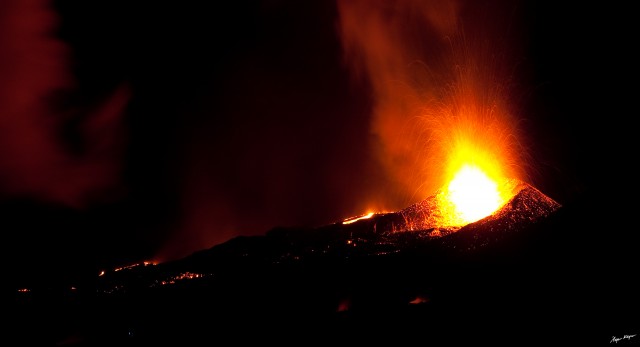We knew there was a big eruption in 1257. Now we may finally know where.
A volcano in Indonesia may be the location of a massive “mystery eruption” that has perplexed volcanologists for decades, according to a new study. The eruption occurred in 1257, and it could have been one of the events that started a 600-year cold period called the Little Ice Age.
Volcanic eruptions release sulfur into the atmosphere. After cooling the Earth by reflecting sunlight, this material eventually falls back on Earth and gets deposited on ice sheets. These sulfur samples can be identified in ice cores obtained from polar regions. From the records, Clive Oppenheimer, a volcanologist at the University of Cambridge, found that an eruption in 1257 have been the largest release of sulfur in the past 7,000 years.
But where did the eruption happen? “Not being able to find the volcano can be discomforting,” said Thomas Crowley, a geoscientist at the University of Edinburgh. “If the sulfur wasn’t released by a volcano, it means something very strange is going on that we don’t know about.”


But locating the volcanic source can be tricky. For the 1257 eruption, there were many candidates: Okataina in New Zealand, El Chichón in Mexico, Quilotoa in Ecuador, and Samalas in Indonesia.
To narrow down their choice, Franck Lavigne at the Pantheon-Sorbonne University and his colleagues had to consider many types of data, as they describe in a paper just published in the PNAS. “They do a great job of combining historical data, geochemistry evidence, carbon dating, and physical data to arrive at the conclusion,” said Erik Klemetti, a geoscientist at Denison University and author of the popular Eruptions blog. “Their case for it to be Samalas is compelling.”
The historical data comes from Babad Lombok, which are records written down on palm leaves in Old Javanese. They describe a horseshoe-shaped collapse which can occur when empty space is created under a mountain on ejection of a large amount of magma. To provide an additional match, Lavigne had to rely on comparing geochemical fingerprints, which give a unique ratio of chemicals present in the ash from every volcano. The team took geochemical fingerprints from volcanic ash in ice core samples and the possible sites of volcanoes.
“In this study, the error margins for the chemical analysis are quite large,” said Rebecca Williams, a volcanologist at the University of Hull. “But I appreciate that matching the ice core data with volcanic samples is very difficult.” This is because the ice core samples often yield only one or two grains of the ash, which need to be subjected to many tests.
Volcanic eruptions can have a large impact on the climate, which will then have social, economic, and environmental knock-on effects. An 1815 eruption in Tambora, Indonesia, is infamous for producing the “year without summer,” one of the chilliest years in Europe’s recent history. It was followed by a mass shortage of food.
Lavigne speculates that the Samalas volcano could have had similar impacts. One bit of speculation is about thousands of bodies recovered from Spitalfields in London. Many of these were found to have been shoved in a single grave, indicating some sort of crisis. According to Lavigne, they’ve been recently dated to 1258, only one year after the Samalas eruption.
The Babad Lombok also notes that the volcanic eruption destroyed Pamatan, then capital of the Lombok Kingdom. “There is a good possibility that an ancient city lies beneath the ash and pumice deposits of the Samalas volcano,” said Oppenheimer, also a co-author of the study. “Ruins under such deposits are not so uncommon,” adds Williams, but finding a whole city might be.
More important, though, could be Samalas volcano’s role in triggering the Little Ice Age. In a 2012 study in Geophysical Research Letters, scientists used climate models to show that a series of eruptions may have triggered the onset of the Little Ice Age. Although the precise timing varies somewhat, this period is typically considered to have occurred between 1250 and 1850.
“A single eruption could not have caused such long-term climate change,” said Klemetti. “Instead, it had to be a sequence of large eruptions, one of which might be the Samalas volcano.”



0 comments:
Post a Comment